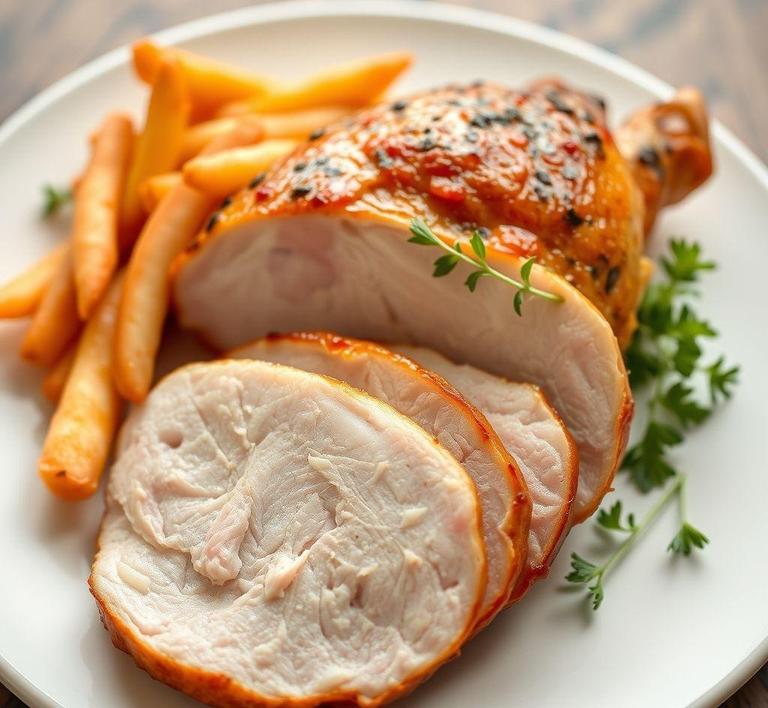So, you’ve got a turkey breast that’s been sitting in the fridge for a little longer than you planned, or maybe you’ve thawed it and decided you’re not ready to cook it just yet. The good news is, yes, you can refreeze turkey breast! However, there are a few things to keep in mind to ensure it stays safe and tasty. Refreezing poultry can sometimes affect its texture, but if done right, it can still be a great option. In this guide, we’ll walk you through the best practices for refreezing turkey breast, so you can keep your leftovers or extra portions fresh and ready for future meals without worry.
Can You Refreeze Turkey Breast?

Refreezing turkey breast is a topic that often sparks confusion, as many people are unsure whether it’s safe or advisable to refreeze meat, particularly poultry. The short answer is: yes, you can refreeze turkey breast, but it comes with certain conditions and considerations. Understanding these rules and guidelines can help prevent the risk of foodborne illness and preserve the flavor and texture of the turkey.
The key to safely refreezing turkey breast lies in how it’s been handled and how long it’s been stored. If you’ve thawed turkey breast in the refrigerator, it’s generally considered safe to refreeze it, but if the turkey was thawed using the microwave or under warm water, it’s best not to refreeze it. These thawing methods can bring the turkey into the "danger zone" for bacterial growth (between 40°F and 140°F), so it’s advised to cook the turkey as soon as possible after thawing, and not refreeze.
Additionally, refreezing turkey breast that has been previously frozen and then thawed can compromise its safety if it has been left out at room temperature for more than two hours. Bacteria multiply quickly at higher temperatures, so taking precautions, such as ensuring your turkey never sits out for extended periods, is crucial.
How To Refreeze Turkey Breast?
If you’re determined to refreeze turkey breast, following the proper steps can help maintain its quality and ensure safety. Here’s a step-by-step guide:
- Thaw Correctly: If the turkey breast was previously frozen, always thaw it in the refrigerator, not on the counter. Thawing in the fridge allows it to remain at a safe temperature (below 40°F) throughout the process. If you’re in a hurry, you can also thaw turkey breast in cold water, but you must cook it immediately afterward-no refreezing at this stage.
- Check Freshness: Before refreezing, make sure the turkey breast hasn’t been sitting at room temperature for an extended period. Ideally, poultry should not be left out for more than two hours. If it has been out longer, it’s better to discard it for safety reasons.
- Wrap It Tight: When it comes time to refreeze, proper packaging is key. Use freezer-safe plastic wrap, aluminum foil, or vacuum-seal bags to ensure the turkey is tightly sealed and protected from air exposure. If using plastic bags, try to remove as much air as possible before sealing. Air exposure leads to freezer burn, which negatively impacts the texture and flavor of the turkey.
- Label and Date: Always label the turkey with the date it was refrozen. This helps you keep track of how long it’s been in the freezer. Turkey breast can typically be stored in the freezer for up to 6 months, but the sooner you use it, the better the quality.
- Consider Portioning: If you’re unsure whether you’ll use the entire turkey breast at once, consider portioning it into smaller pieces before freezing. This way, you can refreeze only the amount you plan to use at a given time, which helps prevent unnecessary thawing and refreezing cycles.
- Thaw Before Use: When you’re ready to use the refrozen turkey, it’s important to thaw it properly. The safest way to do this is to place it in the refrigerator for 24 hours to slowly thaw. Quick thawing methods can affect the texture and moisture of the meat.
Quality Impact
Refreezing turkey breast will have an inevitable impact on its quality, and understanding these effects will help you manage expectations. The primary changes come in the form of texture, moisture retention, and flavor. Here’s what to expect:
- Texture: Turkey breast, especially when refrozen multiple times, tends to lose some of its original texture. Freezing causes water crystals to form within the meat’s cells, which can rupture the cell walls when it’s thawed. As a result, the meat can become somewhat dry and grainy upon cooking, especially if it has been refrozen more than once. While refreezing once may not drastically affect the texture, doing it repeatedly can cause the turkey to become tougher and less tender.
- Moisture Loss: The process of freezing and thawing causes moisture to escape from the turkey breast. When you refreeze the turkey, this moisture loss can worsen, leaving the meat drier than before. This is particularly noticeable when roasting or reheating the turkey breast, as the cooking process can further draw out moisture. To help counteract this, consider marinating or basting the turkey when cooking, which can help retain some of the moisture and improve the overall eating experience.
- Flavor: Refrozen turkey breast may lose some of its original flavor. Freezing can dull the meat’s natural taste and make it less juicy, especially if it has been stored for a prolonged period. Additionally, freezer burn-caused by air exposure-can develop if the turkey isn’t wrapped securely. Freezer-burned turkey will taste bland, dry, and have an off-putting texture, making it less enjoyable to eat.
- Nutritional Value: Nutritionally, the process of refreezing and thawing turkey doesn’t dramatically alter its content, but there can be a slight degradation of certain vitamins and nutrients over time. The longer the turkey is stored in the freezer, the more noticeable these minor changes can become, particularly for sensitive nutrients like B-vitamins.
Refreezing turkey breast is possible, but it’s important to understand the conditions under which it should be done and the effects it may have on the meat’s quality. The most crucial factor is ensuring that the turkey is handled safely throughout the thawing and refreezing process. Always thaw turkey breast in the refrigerator and avoid letting it sit at room temperature for too long. Once refrozen, the texture, moisture content, and flavor will likely be affected, though with proper care, you can still enjoy a reasonably tasty dish.
In short, while it’s safe to refreeze turkey breast under the right circumstances, it’s important to be mindful of how many times it’s been frozen and thawed. If preserving the taste and texture is your top priority, limit refreezing and instead try to cook or use the turkey within a reasonable time frame after its initial thaw. By following the best practices for storage and handling, you can ensure a safe and relatively pleasant meal, even after refreezing your turkey breast.
Is It Safe To Refreeze Turkey Breast?
The question of whether it’s safe to refreeze turkey breast is one that comes up frequently, especially during holidays like Thanksgiving or Christmas, when leftovers often pile up. To answer the question simply: it is generally safe to refreeze turkey breast, but only under specific conditions. However, there are important nuances that need to be understood to ensure both safety and quality.
When turkey breast is initially thawed, either in the refrigerator or using another safe method, the proteins and moisture inside begin to break down. This process can make the meat more susceptible to bacteria if not handled properly. Freezing turkey breast prevents bacterial growth, but once thawed, it enters a danger zone where bacteria can grow if left too long or improperly stored. Refreezing turkey breast after it has thawed can lead to an increased risk of bacterial contamination unless the meat is handled carefully.
The key to safely refreezing turkey breast lies in how it was thawed and how long it has been out of the freezer. According to food safety guidelines, if the turkey breast was thawed in the refrigerator, and has not been left out at room temperature for an extended period, you can safely refreeze it. However, if the turkey was thawed using the microwave or in warm water, refreezing is not recommended because these methods can bring the turkey breast into the danger zone of bacterial growth.
Signs That Turkey Breast Should Not Be Refrozen
There are certain visual, textural, and olfactory clues that can indicate turkey breast should not be refrozen. These signs are critical in maintaining both safety and the quality of your meal:
- Off or Sour Smell: One of the most telling signs that turkey breast should not be refrozen is a foul odor. Fresh turkey will have a clean, neutral smell, while spoiled turkey may have a sour, rancid, or ‘off’ scent. If the turkey emits any unpleasant smell, it has likely started to spoil and should not be refrozen.
- Slimy Texture: If the turkey breast feels sticky, slimy, or tacky to the touch after thawing, this is a sign of bacterial growth, and refreezing is not advisable. The slimy layer on the meat is caused by the proliferation of harmful bacteria, which makes it unsafe to eat.
- Discoloration: Fresh turkey breast should be a light pinkish hue. If the turkey has turned gray, brown, or has any dark patches, it might have started to spoil. Though color alone isn’t a definitive sign of spoilage, discolored turkey should be thoroughly examined for other signs of spoilage before making the decision to refreeze.
- Extended Thawing Time: Turkey breast that has been left in the refrigerator for more than 1-2 days or at room temperature for longer than 2 hours is more likely to be unsafe. If it has been stored improperly or thawed for too long, the risk of harmful bacteria like Salmonella and Campylobacter grows significantly. In such cases, the meat should be discarded, not refrozen.
- Visible Mold: Any sign of mold growth on the surface of the turkey breast is a definite red flag. Mold can grow in moist environments, and if it appears on thawed turkey, it indicates the presence of spoilage and bacteria. The turkey should not be refrozen or consumed.
Common Refreezing Mistakes
Refreezing turkey breast may seem like a practical way to preserve leftovers, but there are common mistakes that people often make when doing so. These errors can affect both the safety and quality of the meat:
- Refreezing Without Proper Cooling: One of the biggest mistakes is refreezing turkey breast that has not been properly cooled after thawing. Turkey breast should never be refrozen if it has been sitting out at room temperature for over 2 hours, as bacteria can multiply rapidly in this time. To avoid this, always ensure that the turkey has been stored in the fridge and has cooled down to a safe temperature before refreezing.
- Repeated Freezing and Thawing: While it is safe to refreeze turkey breast once under the right conditions, repeated freezing and thawing can degrade the quality of the meat. Each time the turkey is thawed, it loses moisture, which can cause the meat to become dry, tough, and less flavorful. To prevent this, it’s better to refreeze turkey breast only once.
- Not Using Proper Packaging: When refreezing turkey breast, many people make the mistake of not using airtight packaging or freezer bags. If turkey breast is not sealed properly, it can become exposed to freezer burn-a condition where the surface of the meat becomes dehydrated, leading to dry, discolored patches. Always use high-quality, heavy-duty freezer bags or vacuum-sealed bags to keep the meat sealed and protected.
- Refreezing Cooked and Uncooked Meat Together: If you have both cooked and raw turkey breast, it is important to keep them separate when refreezing. Cooked turkey can be refrozen safely, but raw turkey should not be refrozen if it has been previously thawed. This distinction ensures proper food safety and reduces the risk of cross-contamination.
- Ignoring Use-By Dates: If you plan to refreeze turkey breast that has already been stored in the refrigerator for an extended period, it’s crucial to check the use-by date. Refreezing does not extend the shelf life indefinitely. In fact, the longer turkey has been stored, the more likely it is to spoil once thawed, even if you refreeze it.
Tips And Tricks
Refreezing turkey breast can be done safely and without sacrificing flavor if you follow these expert tips and tricks:
- Use Freezer-Safe Bags: Invest in freezer-safe, resealable bags or vacuum-seal bags to store turkey breast. This not only preserves the freshness of the turkey but also prevents the formation of ice crystals, which can degrade the quality of the meat when it’s thawed again.
- Label and Date Everything: Always label your freezer bags with the date and content. This will help you track how long the turkey has been in the freezer, and ensure you use it within an optimal timeframe. Turkey breast should ideally be consumed within 3 to 4 months of being refrozen to ensure peak quality.
- Portion Control: If you have a large turkey breast, consider cutting it into smaller portions before freezing. This way, you only thaw what you need, avoiding the risk of repeatedly thawing and refreezing the entire piece of meat.
- Thaw Safely: When you’re ready to use your refrozen turkey breast, always thaw it safely in the refrigerator (not at room temperature or in warm water). This keeps the turkey within safe temperature ranges and prevents any bacterial growth.
- Cook Immediately After Thawing: After thawing refrozen turkey breast, it should be cooked immediately. Don’t leave it thawed for too long or refreeze it again. The faster you cook it, the better the flavor and safety.
Conclusion
In conclusion, refreezing turkey breast is possible and can be safe when done properly, but it comes with its fair share of precautions. Always ensure that the meat has been properly thawed in the fridge, stored correctly, and not left out for too long before refreezing. Be mindful of the signs that indicate whether turkey should be discarded, such as unpleasant odors, slimy texture, or discoloration. Avoid common mistakes like refreezing improperly cooled meat or packaging it poorly. By following the right steps, you can refreeze turkey breast safely and enjoy it in the future without sacrificing quality or safety. When in doubt, it’s always better to err on the side of caution-because nothing beats the satisfaction of a safe, well-prepared meal!


